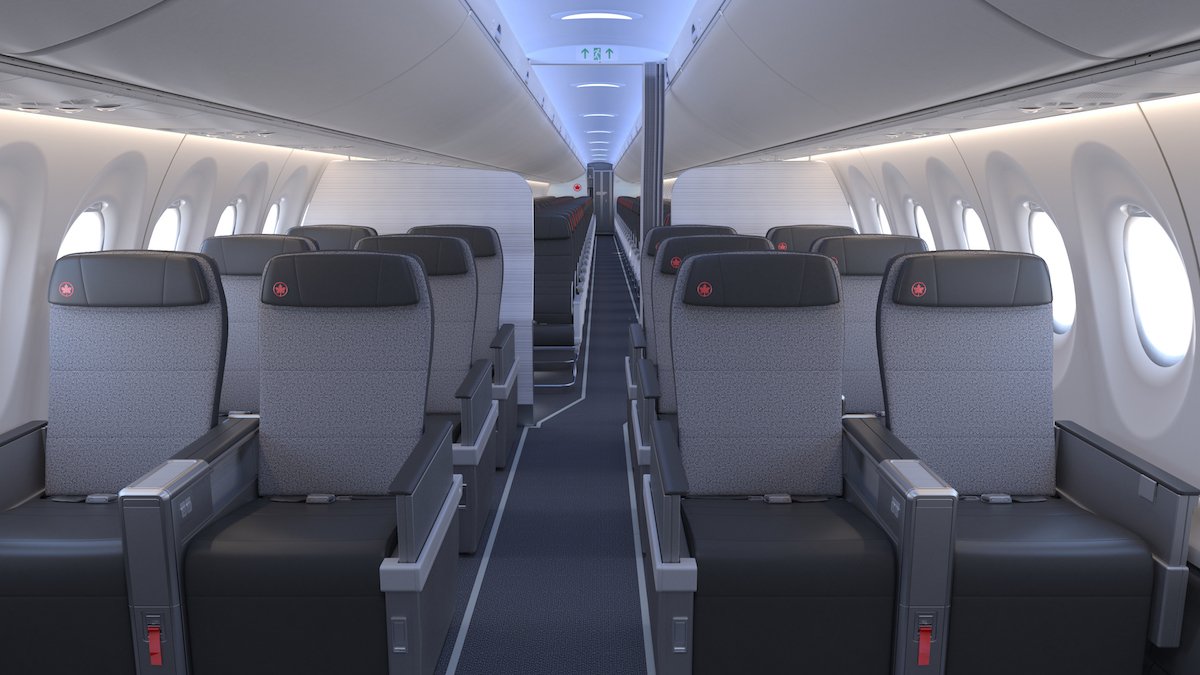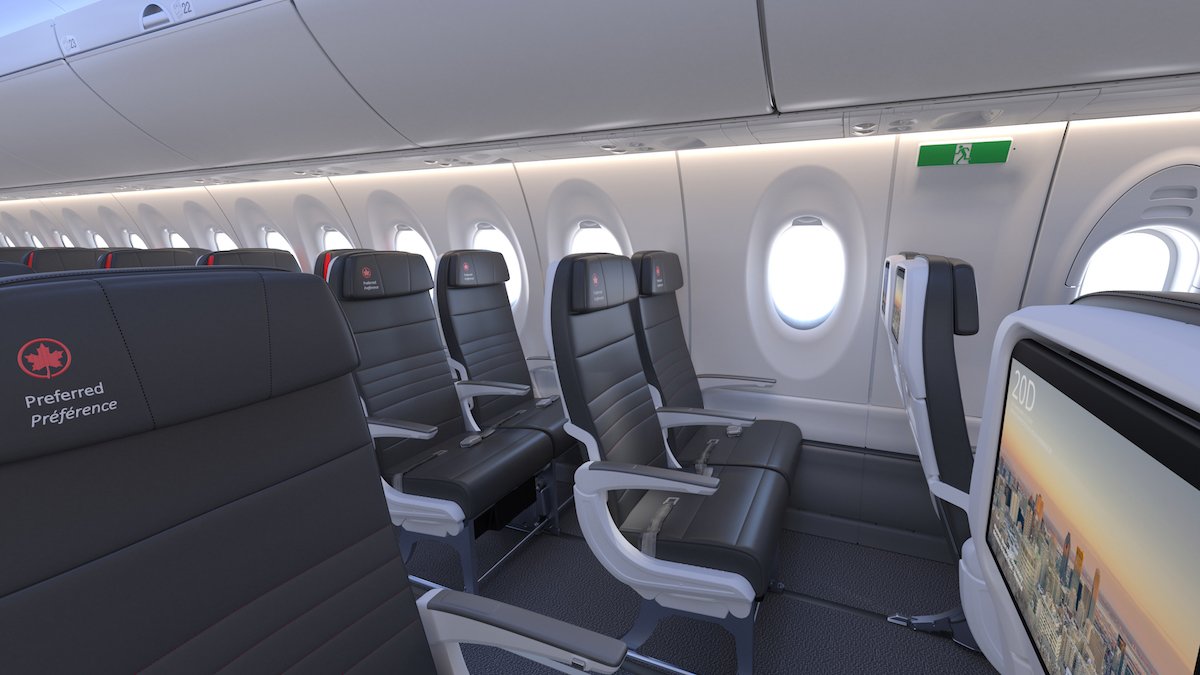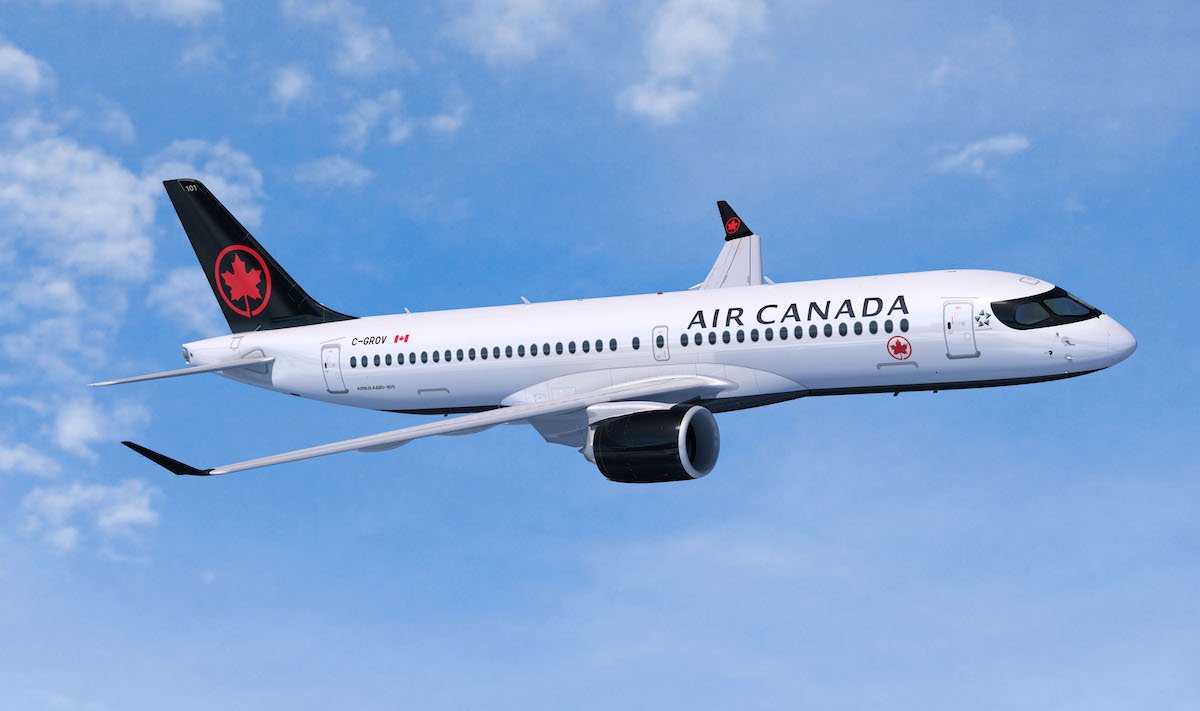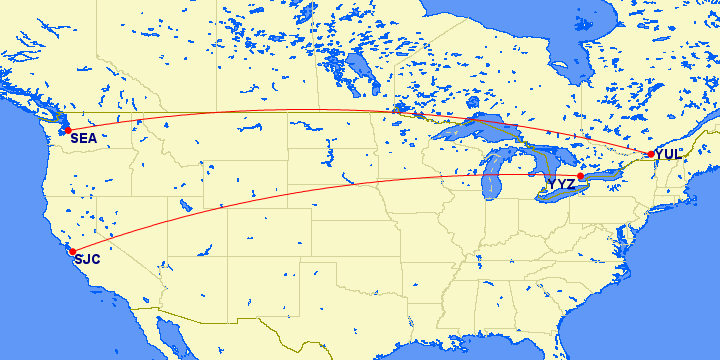The Airbus A220 is a nifty plane that offers both a a great experience for passengers, as well as favorable economics for airlines. While Delta was the first North American airline to take delivery of the A220, another airline on the continent will soon take delivery of their first such plane (and they’ll be the first North American airline to take delivery of the A220-300, as so far Delta only has A220-100s). The A220-300 has a range of 3,200 nautical miles.
Air Canada has a total of 45 Airbus A220-300s on order, and they’ll take delivery of their first one before the end of the year. The airline has now revealed the configuration for these planes, as well as the first routes to be launched with these planes.
What to expect from Air Canada A220
Air Canada’s A220-300 will be in a two class configuration with a total of 137 seats:
- Business class will consist of 12 seats, in a 2-2 configuration
- Economy class will consist of 125 seats, in a 2-3 configuration


These planes will feature the widest economy seats in Air Canada’s fleet, as well as the largest overhead bins of a plane this size.

Every seat will feature a Panasonic eX1 in-flight entertainment system with more than 1,000 hours of entertainment. Furthermore, the plane will feature satellite based high speed Wi-Fi, and USB A, USB C, and AC power available to every passenger.
From an environmental standpoint, the plane will result in a 20% reduction in fuel consumption compared to previous generation aircraft.

Air Canada’s first A220 routes
Air Canada will take delivery of their first A220-300 later this year. The airline will first deploy these planes from Montreal and Toronto to existing Canadian and transborder markets, such as to Ottawa, Winnipeg, Calgary, Edmonton, and New York.
Beyond that, the plane will open up two new routes initially:
- Air Canada will operate daily, year-round flights, between Montreal and Seattle, as of May 4, 2020; this complements existing flights to Seattle from Vancouver and Toronto
- Air Canada will operate daily, year-round flights, between Toronto and San Jose, as of May 4, 2020; this complements existing flights to San Jose from Vancouver

It’s cool to see the airline using the A220 to launch some new routes that might not have previously been practical.
Bottom line
The A220 is a lovely plane, both from the perspective of passengers and airlines. It’s great that we’ll soon see more of these in the North American skies.





"Maybe they can finally open IAD-YVR."
Ditto that sentiment.
@Justin
The A223 (or CSeries if you're feeling some Canadian patriotism) is planned to fully replace the existing E190 and A319 fleets.
The A223 will replace the E190s first, as they have had higher operating and maintenance costs than AC would have liked, while allowing a significant range and incremental capacity increase.
Replacement of the A319 fleet will follow, with some of the younger 319's likely going over to RV. Once the MAX's...
@Justin
The A223 (or CSeries if you're feeling some Canadian patriotism) is planned to fully replace the existing E190 and A319 fleets.
The A223 will replace the E190s first, as they have had higher operating and maintenance costs than AC would have liked, while allowing a significant range and incremental capacity increase.
Replacement of the A319 fleet will follow, with some of the younger 319's likely going over to RV. Once the MAX's return to the AC fleet, the mainline A319's will no longer be needed for trans-Atlantic missions.
The order of 45 aircraft will allow for full replacement of the E190 and A319 fleets with an extra five incremental additions to the overall fleet.
@keitherson - Does it not occur to you that some people are willing to pay for such a product?
Where are the lie-flat beds on my regional jets that are not commercially viable so that I can redeem my credit card transferred-points for free award seats???
Some of you readers are delusional.
@Justin
The A220 will be used to replace A319s as well as some E190s. Potentially also some A320s due to the MAX issues at the moment. The A321s aren't due for replacement quite yet as they're much newer. Probably waiting for the MAX 9 to replace those. Now that I think of it, the A220 might also replace the E175.
My impression after 2 flights on Delta's A220-100. First Class.
1. Row 1 has about 34 in of pitch.
2. Rows 2 and 3 have 36 in of pitch.
3. Space from the floor to the bottom of the seat seems narrow, and full backpack won't fit under it.
4. Arm rests are too narrow, there is no way to arms can share with hitting the other. Drink holders are also...
My impression after 2 flights on Delta's A220-100. First Class.
1. Row 1 has about 34 in of pitch.
2. Rows 2 and 3 have 36 in of pitch.
3. Space from the floor to the bottom of the seat seems narrow, and full backpack won't fit under it.
4. Arm rests are too narrow, there is no way to arms can share with hitting the other. Drink holders are also impacted and there is no extension.
5. Bathroom is spacious BUT the seat doesn't stay up, and there is not grab handle to not touch the seat that might be contaminated with urine or whatever.
6. Overhead bin space is ample.
The Delta wireless IFE works well. The myflight has great "experiences" versions of display.
On a side note, I like the first class experience on the CRJ900 with the Atmosphere interior, for flights 2 hours or so......physical seating attributes are much more comfortable.
Wonder if the seat pitch is going to be like Rouge....of corset will be, it's AC!
@Jordan
@Tom
Regional jets are mostly classified by seats not range. Delta puts the A220 as a mainline jet.
Another interesting fact.
The 737 was originally designed as a regional jet. Look at it now.
Lie flat seats on these routes are nice but not necessary. These are not red eyes and business travellers probably prefer a more direct route!!
@ Tom
I have to disagree that there isn't demand for lie flat on Trans-cons. On the SFO - EWR/JFK route alone United alone flies 14 per day all with Lie Flat seats with a combination of 757/777/787. Most are in the old seats in high density bus class.
Jet Blue flies 6 dailys all with MINT, and American has 5. Both in A321's
Then there is LAX - NYC which I...
@ Tom
I have to disagree that there isn't demand for lie flat on Trans-cons. On the SFO - EWR/JFK route alone United alone flies 14 per day all with Lie Flat seats with a combination of 757/777/787. Most are in the old seats in high density bus class.
Jet Blue flies 6 dailys all with MINT, and American has 5. Both in A321's
Then there is LAX - NYC which I haven't even counted.
I've never been on a United flight going to EWR that business class hasn't been totally full, or Jet Blue.
@Tom
If we’re talking about Air Canada, right now 6/15 YYZ-YVR, 2/5 YUL-YVR, 3/6 YYZ-LAX, 1/3 YUL-LAX, and 2/5 YYZ-SFO are widebodies with flat beds. Sure it’s probably more about capacity than flat beds in business, but you can’t dismiss it entirely.
Great news. YUL-SEA is long overdue.
Plus I totally disagree that there is no market for lie-flat seats transcon. Quite the opposite I think it’s the future of transcon flights.
B788/B789 and A330 flights from YYZ/YUL to YVR/LAX/SFO are always full or near full.
But if they didn’t put lie-flat on the max 8, i don’t see why they would include them on C-series. Was hoping for a better J/Y ratio like Delta....
Jordan,
It is classified as a regional jet despite its range.
There isn't much demand for lie-flat even on trans-con routes, Only JetBlue Mint and AA A321T have then on a regular basis, and only on high value routes like JFK-SFO. Other than that we might find the odd 777 or A330 on a few routes, but the vast majority of aircraft on transcon-routes do not have lie-flat seats.
@Tom - there is no such thing as a regional jet. This jet is built to fly over 3000 miles (is that regional?)
Maybe they can finally open IAD-YVR.
Varun
I doubt there is much demand for lie-flat seats on a regional jet. And it would reduce the revenue for the airline.
Do you know which aircraft these A220s are going to replace in Air Canada's fleet? Are they designed to replace the A320-series which have been a mainstay of their domestic fleet for decades?
Great, just not great in Business Class where there ought to be flat-beds.
Always interested in the economics side of these next gen planes. On what basis is the 20% improvement to fuel consumption? It stated previous generation planes but isn’t this a first gen aircraft?